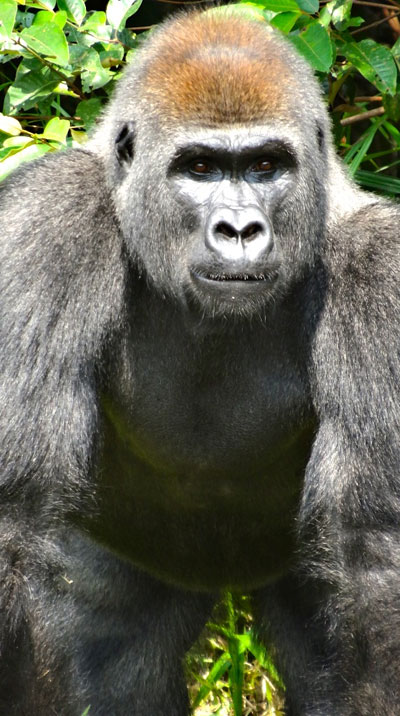Deadly malaria’s evolution revealed
The evolutionary path of the deadliest human malaria parasite, Plasmodium falciparum, has been revealed for the first time. This parasite is a member of a parasite family called the Laverania that only infect the great apes including humans, chimpanzees and gorillas. Scientists from the Wellcome Sanger Institute and their collaborators from the French National Center for Scientific Research (CNRS), French National Research Institute for Sustainable Development (IRD), and the International Centre for Medical Research of Franceville, Gabon, estimate that Plasmodium falciparum emerged as a human-specific parasite species earlier than previously thought.

The results, published today (21 May) in Nature Microbiology provide estimated dates at which branches in the evolutionary tree for the Laverania family of malaria parasites diverged, and give clues as to how deadly parasites emerge.
Nearly half of the world’s population is at risk of malaria and more than 200 million people are infected each year. The disease caused the deaths of almost half a million people globally in 2016*, predominantly children under the age of five.
To discover how Plasmodium falciparum evolved, a team of scientists from the Sanger Institute and their collaborators sequenced and studied the genomes of all known malaria parasites in the Laverania family. Plasmodium falciparum is the only parasite from this group that has successfully adapted to transfer from gorillas to infect humans, and subsequently spread all over the world.
The key challenge of this study was obtaining malaria parasites. The team used blood samples taken from orphaned chimpanzees and gorillas, as part of routine health checks in sanctuaries and nature reserves in Gabon.
“We had to work with tiny blood samples taken from these protected species as part of health check-ups. Even then, there were so few parasites present that we had to devise strategies to amplify the material to obtain good quality genomes.”
Dr Franck Prugnolle Co-lead author from CNRS and MIVEGEC Laboratory in France and the International Centre for Medical Research of Franceville, Gabon
Scientists discovered that the evolutionary lineage leading to Plasmodium falciparum emerged 50,000 years ago, but did not fully diverge as a human-specific parasite species until 3,000 to 4,000 years ago.
“We sequenced the genomes of all known species in a family of malaria parasites that gave rise to the deadliest form of human malaria. We estimated when Plasmodium falciparum and its relatives diverged and found evidence that the recent expansion of modern humans created the home in which the parasites irreversibly evolved into a human-specific form.”
Dr Matt Berriman Co-lead author from the Wellcome Sanger Institute
The researchers analysed the genomes of the malaria parasites in the Laverania family tree and discovered a chain of events that led to the emergence of Plasmodium falciparum.
“Using the parasites’ genomic data, we constructed their family tree and identified major genetic events that led to their emergence. The movement of a single cluster of genes was an early crucial event that enabled the malaria parasites to infect the red blood cells of a new host species. After reconfiguring and fine-tuning the repertoires of genes that interact with the host and the vector, the parasites were able to establish long term, transmissible infections in humans.”
Dr Thomas Otto Co-first author now based at the University of Glasgow
More information
*Figures from the 2017 World Health Organisation report http://www.who.int/malaria/publications/world-malaria-report-2017/en/
Publication:
Thomas Otto et al. (2018) Genomes of an entire Plasmodium subgenus reveal paths to virulent human malaria. Nature Microbiology. DOI: 10.1038/s41564-018-0162-2
Funding:
This work was supported by ANR ORIGIN JCJC 2012, LMI ZOFAC, CNRS, CIRMF, IRD and Wellcome (grants WT 098051 and 104792/Z/14/Z).
Selected websites
National Center for Scientific Research, France
The French National Center for Scientific Research is Europe’s largest public research institution. It produces knowledge for the benefit of society. With nearly 33,000 employees, a budget exceeding 3.3 billion euros in 2016 (including a self-generated income of 749 million euros), and offices throughout France, the CNRS is present in all scientific fields through its 1144 laboratories. With 21 Nobel laureates and 12 Fields Medal winners, the organization has a long tradition of excellence. It carries out research in mathematics, physics, information sciences and technologies, nuclear and particle physics, Earth sciences and astronomy, chemistry, biological sciences, the humanities and social sciences, engineering and the environment. http://www.cnrs.fr/index.html
French National Research Institute for Sustainable Development (IRD), France
The French National Research Institute for Sustainable Development (IRD), an internationally recognised multidisciplinary organisation working primarily in partnership with Mediterranean and inter-tropical countries, is a French public establishment under the joint authority of the French Ministry of Higher Education and Research and the Ministry of Foreign A€airs and International Development. Via its network and presence in fifty or so countries, it takes an original approach to research, expertise, training and knowledge-sharing, to the benefit of countries and regions that make science and innovation key drivers in their development. http://en.ird.fr/
The Wellcome Sanger Institute
The Wellcome Sanger Institute is one of the world’s leading genome centres. Through its ability to conduct research at scale, it is able to engage in bold and long-term exploratory projects that are designed to influence and empower medical science globally. Institute research findings, generated through its own research programmes and through its leading role in international consortia, are being used to develop new diagnostics and treatments for human disease. To celebrate its 25th year in 2018, the Institute is sequencing 25 new genomes of species in the UK. Find out more at www.sanger.ac.uk or follow @sangerinstitute
Wellcome
Wellcome exists to improve health for everyone by helping great ideas to thrive. We’re a global charitable foundation, both politically and financially independent. We support scientists and researchers, take on big problems, fuel imaginations and spark debate. wellcome.org


